
Jan-Erik Nilsson, Scr., AD 2023
This phrase suggests that the possibility of experiencing a particular sensation or feeling on an 18th-century East Indiaman exists, but does not imply a strong likelihood. This is correct, since we needed to build one first.
To save you the trouble, I can tell you right away. Imagine a low-ceiling barnyard, about 1,60 m between the decks and barely enough height to stand up, ten meters wide, about 40 meters long, with a long corridor on each side. It floats and moves with the weather. And you share the space with 120 other men and an untold number of livestock that you, God willing, will have eaten sooner or later.
Luckily, one might say, the ships systems' designer Erik Lincoln gave me a flat no, on my suggestions for authenticity and stuck to a much more modern solution in the Gotheborg III we actually built. Here is the story anyway if you are still curious.
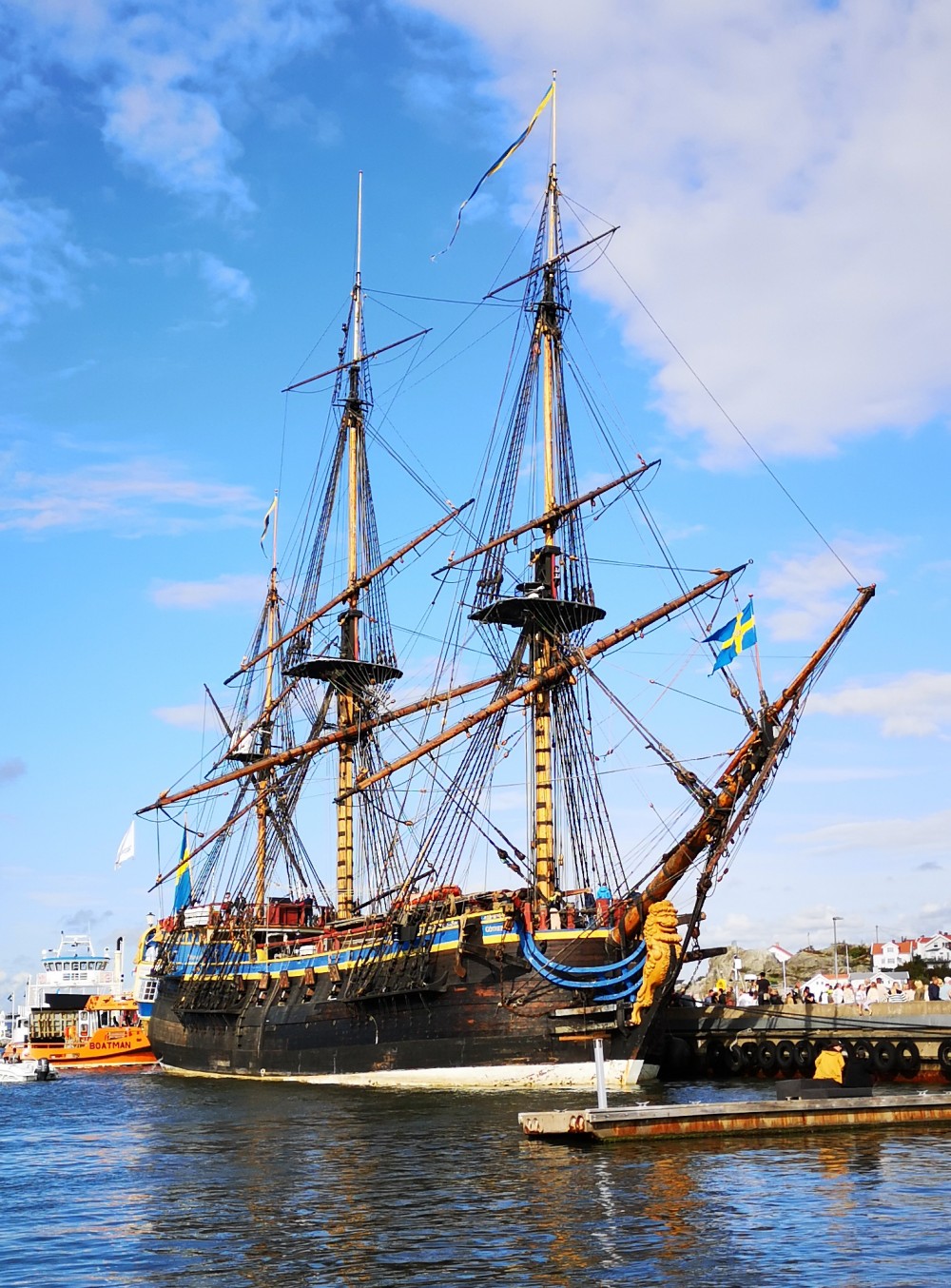
As it so happened, for a few days at the end of 2023, our Gotheborg III visited the Gothenburg Southern archipelago, near Vargö Håla, where the original embarked in 1743. Now, 280 years later, in a symbolic twist of events, she returned to almost the very spot where her historic namesake began her last voyage. More picture from this visit to the Southern Archipelago in 2023 here.
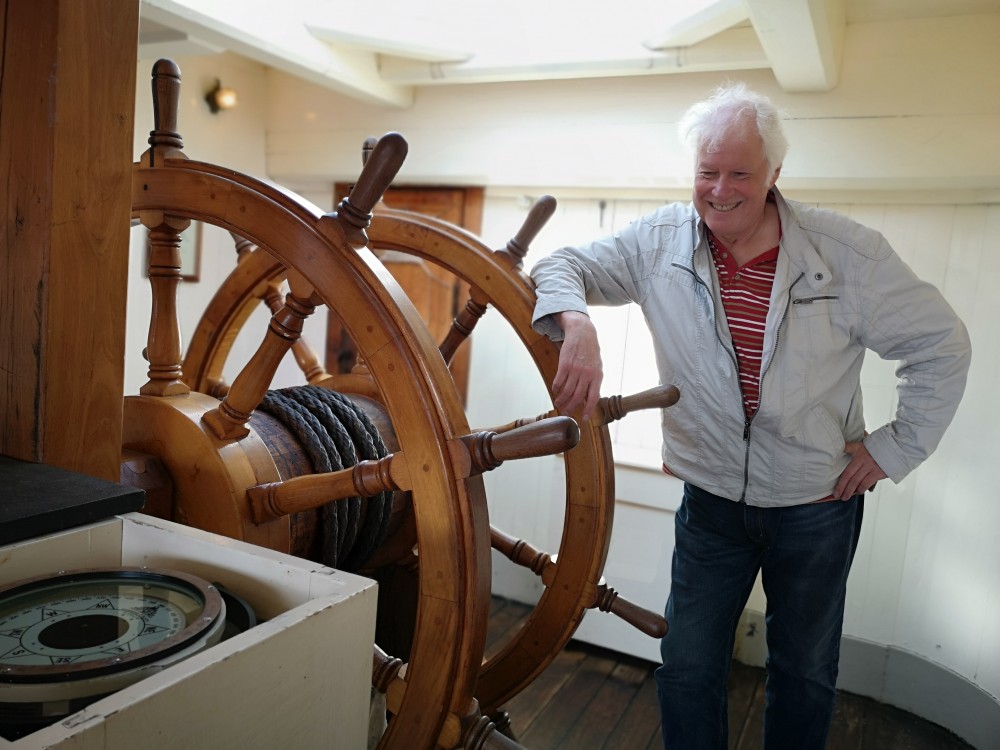
I took some pictures to share with you, showcasing how a mid-18th-century East Indiaman would have appeared inside and out, in case you too have been wondering. The size, proportions, hull, and rig are as close as we could get to the original while still being allowed to sail it to China. Many have asked those of us who worked for free how come we could go through all of this with our own money and years of our life; I guess we all had our motivations. I guess, to each of us, you can make a list. On top of mine was curiosity and knowing this was a once-in-a-lifetime chance that nobody would ever be able to offer again.
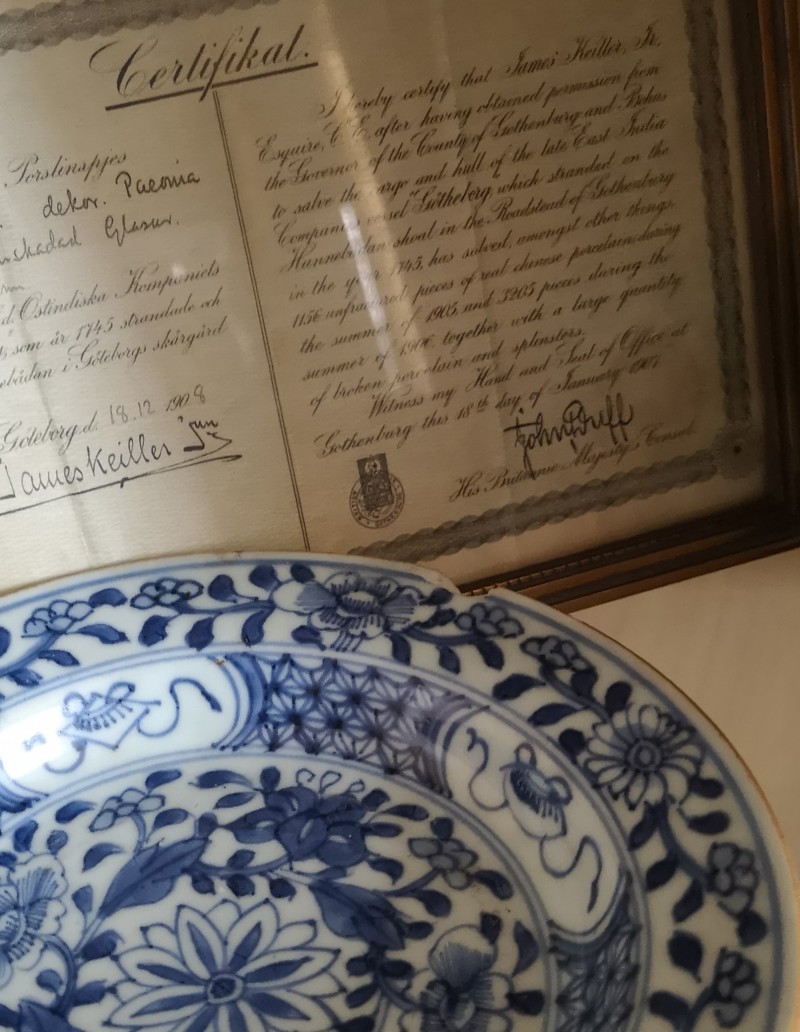
Dish brought up by James Keiller and Carl Lyon during their salvage operation 1906-07. A large part of the cargo was sold by James Keiller together with a certificate telling about the background. Souvenirs like this occasionally occurs in the antiques trade. Photo © JE Nilsson, Coll. 2023
Already in 1976, I had started to become seriously interested in Chinese porcelain. Fresh out of school I invested my first paycheck in a large 18th century serving dish, bought a few books and later next day, went back and bought a vase I still have. I was amazed to discover that just a few blocks from where I lived, there was the former head office of the 18th-century Swedish East India Company (1731-1813). Moreover, not only was the head office building still standing, it was now the Historical Museum and they had lots of porcelain and other artifacts from the time of the East India company. Somehow it felt like the time had stood still when you walked around in there among the old auction room and storage vaults, still numbered.
My interest grew as I realized that a fully laden Swedish East Indiaman had sunk just outside of the Gothenburg harbor and was partially brought up as recently as 1906-07. A significant quantity of porcelain had been recovered, some of which was sitting in a large cabinet in the Museum.
This discovery made me a frequent visitor at the Museum. I also found out about the mid-19th-century salvage operations by Mr. James W. Bourn (1864-65), Johan Kjellberg (1866), Captain M. Lampa and Mr. Chudley, Birmingham, (1875-76). Further information, including a handwritten excavation report signed James Keiller (1907) were available in the archives of the Museum of Maritime History in Gothenburg, complemented by a substantial collection of private belongings of the crew.
Eventually, I began delving into the history of the Swedish East India Company (1731-1813), and the mystery that seemed to shroud the sinking of the Götheborg in 1745. By this time, I had also started to find Chinese porcelain among the many antiques shops in the city, occasionally finding pieces that must have come from the wreck.
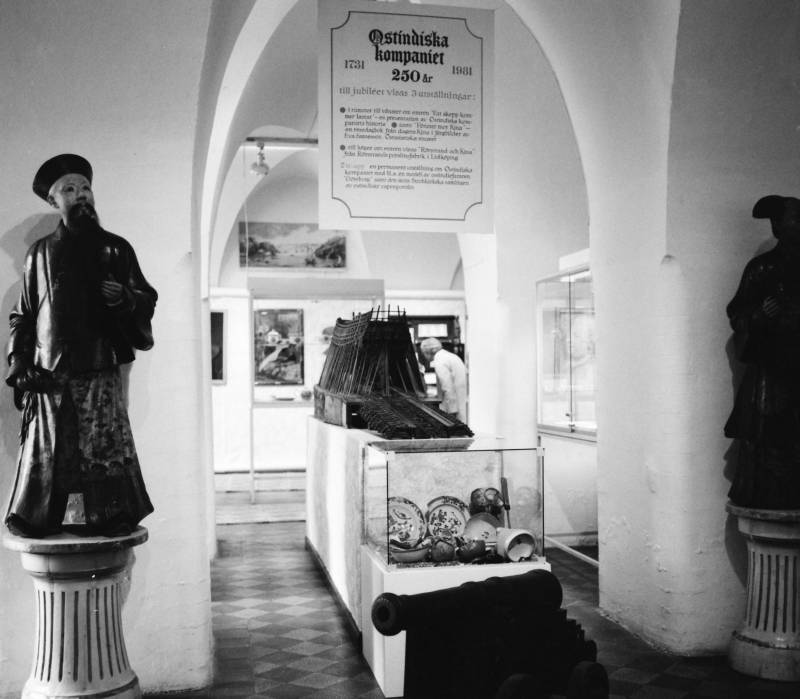
Gothenburg Historical Museum celebrates 250 years anniversary of the founding of the Swedish East India Company (1731-1813). Naturally well featured in the exhibition was porcelain from the Gotheborg that was brought up and donated by James Keiller in 1906. The sign board also offers an exhibition of a model of the 'East Indiaman Gotheborg' and Chinese armorial porcelain from the Strokirk collection.
Photo: Jan-Erik Nilsson, 1981.
In 1981, I was invited to participate in the planning of the Gothenburg Historical Museum's celebration of the 250th anniversary of the founding of the Swedish East India Company, housed in the former head office of the Company, at Norra Hamngatan, which made it all the more interesting. The museum director, Dr. Ingmar Hasselgreen, specialized in architecture and was not particularly that much into porcelain, which meant that this aspect was pretty much left to me. Some porcelain for the exhibition was brought from the museum's affiliate, Lilla Änggården. One evening we went there together to check out a blue and white service that was kept there. I am not sure if it made it into the exhibition since I think it might have been a fairly ordinary willow pattern from possibly after the SOIC company period.
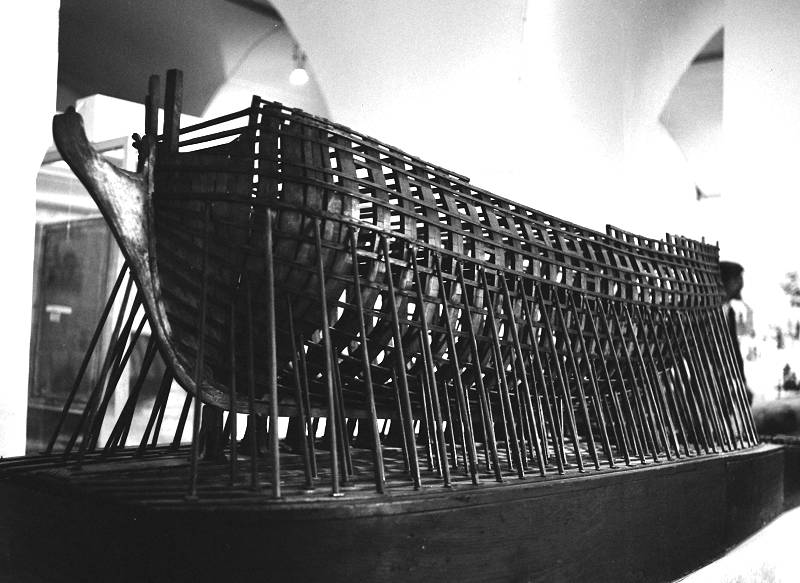
Model of a 18th century East Indiaman being built - aft towards the water - exhibited at the Swedish East India Company 250 year anniversary at the Gothenburg Historical Museum in 1981. Photo: Jan-Erik Nilsson, 1981.
Part of the most interesting exhibits in the museum to me, was the porcelain donated to the Museum in 1919 (GM:7443) by James Keiller who in 1906 to 1907 had thoroughly salvaged what he felt was worth salvaging from the East Indiaman Götheborg.
When collecting anything, it is normal that you also want to know more about it. It appeared to me as if, on the muddy bottom of the Göta River, there rested a fantastically exciting treasure that could help me understand the life and motivations of the 18th-century people who brought this exciting porcelain back home to Sweden in the first place.
It was also obvious that this cargo could prove an invaluable help towards the dating of otherwise un-datable Chinese export porcelain, still available in droves in Swedish antique shops. One thing to remember is that this happened in the early 1980s, which was much before people like Michael Hatcher had started to pick up whole porcelain cargoes in the South East Asian waters.
One question that intrigued me, and to which I could not find an answer, was how come the Gotheborg sank so close to home in the first place? It just must have left some kind of impression in the literature, somewhere?
The local Gothenburg lore was full of memories and myths from the time of the mysterious sinking of the Swedish East Indiaman Gotheborg 240 years earlier. If you had asked anyone at that time, everybody was certain that there had been something funny going on, and that there must have been some monkey business involved. But nobody could tell what. It was just 'felt' that something was wrong
I looked everywhere for answers.
The Regional Archive (Landsarkivet) had a large collection of documents, but nothing that answered this simple question. The Museum of Maritime History in Gothenburg had some documents too, many of which were related to the salvage operation by James Keiller and Carl Lyon around 1906. The one sentence "due to the shortcomings of the pilot" that appeared in Sven T Kjellberg's (1972) book about the Swedish East India Company, remained the only clue there was. Eventually I even find this actual line - a tiny line in a small neat handwriting - in the Ledger A of the SOIC at the Regional Archive (Landsarkivet) in Göteborg. But besides this, all else remained in infuriating darkness.
In the collection of the Historical Museum of Gothenburg, there were also some artifacts that were said to have been made from blackened oak from the hull of the original Gotheborg. On these items, there occasionally occurred small handwritten messages glued or stapled onto them, suggesting that there had been something not quite regular with this sinking. The word used was "underslef," meaning fraud or embezzlement - literally that you deliver less than you charge for. However, nowhere was there any substantial information to be found. Other sources talked about hidden compartments in the hull that had been used for smuggling silk or porcelain but failed to connect the dots to anything like a coherent explanation.
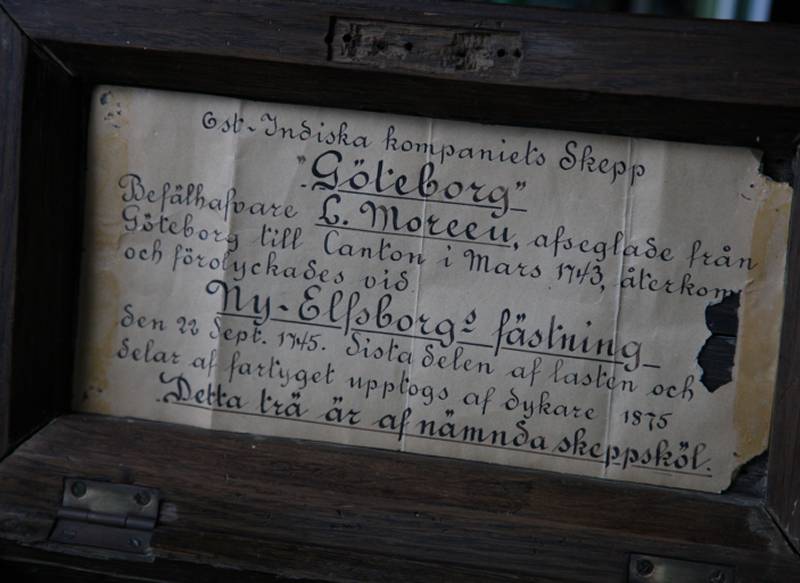
The artifacts could look like this, this box measures 12 times 7 times 3.5 inches (30x18x9 cm) and is "made from blackened oak from the keel" of the East Indiaman Götheborg. The Historical Museum had a chair and a mirror frame inscribed in a similar way. Maybe one particular carpenter had got his hands on the keel and was specializing on this kind of memorabilia as long as the wood lasted?
In this process, I had started to track down and read every single book that could possibly mention this "accident." My hope was that somewhere in a fleeting observation, there would be a recorded contemporary explanation about what had happened, or at least something. Most hope I had, were in contemporary newspapers or travelogues, or published diaries that covered the period, but nothing. One of the reasons was of course that at this time, there were hardly any newspapers, in the first place.
The result of this endeavor is available here as a bibliography, listing 553 titles of books and documents.
By now, I had started to become convinced that there must have been something unusual and irregular going on here. I found it hard to believe that a financial loss of this magnitude, involving both ship and cargo, could have occurred within sight of the home harbor without leaving any clear explanation in any document. With a crew of 200 and a city population of about 5,000, there must have been few families that did not have a relative or neighbor on board. Why was there no explanation?
Then suddenly one reference appeared. It said that "in 1745 the captain Moreen himself was to come down to the City Magistrate to, with 'hand on pen,' sign an explanation to what had transpired." This was good news, but then again, nowhere in the archives could this specific document be found.[footnoot reference to the document]
Anders and Berit Wästfelt have just arrived back home from Eilat and are setting up Marinarkeologiska Sällskapet, Göteborgskretsen (MASG). Anders start looking around for an interesting enough wreck site that could be used for teaching marine archaeological competence and diving skills.
Back in the early 1980s, both Anders Wästfelt and I had unknowingly of each other, began activities that would inevitably make our paths cross. When I think back, there is one picture that comes to mind. It is in the murky office of Göran Sundström, the head of the Maritime Museum of Gothenburg. Anders Wästfelt is laying on the floor playing with a large dog, a big black Labrador, who was quite happy about having his ears ruffled by Anders. Meanwhile, Anders was discussing the possibility of excavating the Hunnebådan wreck site, and using this to educate amateur divers in marine archaeology. Göran saw no problems with that since the site was already very disturbed, so why not.
After initially helping to identify the shards and other finds brought up by Anders and his friends in their first December 1984 Christmas dive, Anders asked me what I hoped to get out of participating in the excavation project, especially since I was not a diver. I remember that I immediately answered, 'One wooden porcelain crate. A wooden box. That's all. It did somehow materialize in the shape of a Pellerin Margarine box full of shards, a gift from David Keiller, but my next item on my wish list would be more complicated.
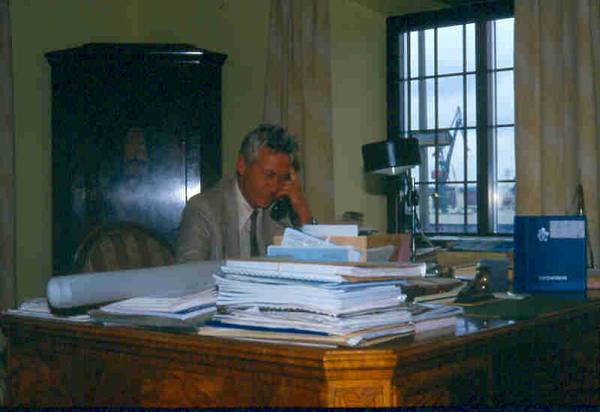
Göran Sundström, 1985, Head of the Gothenburg Museum of Maritime History
The excavation was run as publicly and openly as possible. It caught the imagination and sympathy of wide swaths of people, from international to local governments, to the Swedish industry, and our tourist and business community, not to mention the public at large who all loved it.
During the last few years of the excavation phase, Anders Wästfelt began to conclude his hundreds of lectures and presentations with the final words; that we should build a full-scale replica of the original ship Gotheborg and then sail to China again, often adding that this time, upon our homecoming, we shall not run into a rock and sink.
Personally I had very little to do with the excavation. I was called in sometimes to help with lectures and sometimes to look at the porcelain, but since the find was was well defined there were not much new information to be gleaned from the porcelain that came up. The human part of the finds, was new though. Nowhere had any of the crates the porcelain came in been preserved. Nowhere had it been possible to get that close to the human aspect of those who sailed to China to pick up these treasures. If it was possible at all to get to experience how one of those ships felt like to be inside, this was the opportune moment.
You can't say it was only Anders' idea to try to build her all up again. Everybody involved was thinking about what she had looked like, and felt like, to sail. But it was he and his wife Berit, alas, together with a small group of enthusiastic professionals, who took the idea and pushed it through to completion. Admittedly, my first thought very early on had been; what if we could pick up all those old planks lying down there to see if we could piece the ship back together again? But that was of course impossible. Too much was missing and what was left was in a miserable condition.
Eventually we got the project going. Chinese delegation after delegation visited us, they came, looked and eventually dragged along their unwilling Swedish hosts to see what we were doing - maybe the grandest friendship gesture ever made between any country and China since the barbarians stopped bringing tribute to the Emperor. It was also genuine from the ground up and not initiated nor run by any official authorities.
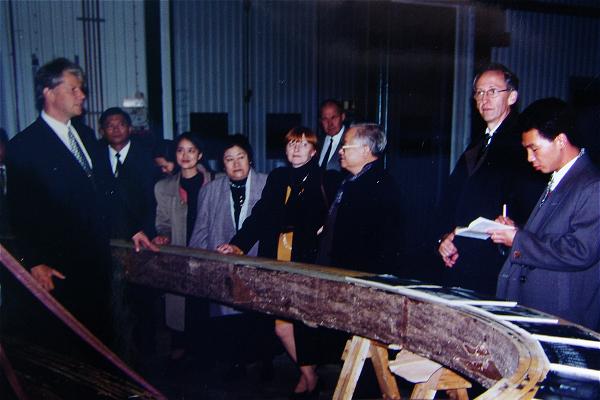
Chinese delegation after delegation came, looked, and dragged along their unwilling Swedish hosts to us, to look at what we were doing. From the left, Jan-Erik Nilsson outlining the rib manufacturing process to the Major of Shanghai, Xu Kuangdi with entourage. To the far right, Nils Olof Ericsson, official interpreter to the Swedish Ministry of Foreign Affairs. In the middle background Bo Alfredsson, CEO of our own building company, the SOIC AB.
It was and actually remained a completely private initiative, run by a handful of people who were volunteering their work, and still going down to the shipyard and working for it on a daily basis. With - and that need to be said - the support of a very large number of knowledgeable friends and advisors, upwards of a thousand small and large sponsors and many private individuals.
Eventually the ship got built and between 2005-2007 made the spectacular voyage to China and back that we had planned for.
Today I don't think anybody feel anything but pride about this project, and that our ship actually got built and did make it to China and back. I also think we did accomplished much of what we wanted, even if all of the purposes and objectives we had in mind did not materialized.
What we knew for sure when we started this in 1992 was that it would become a very beneficial project for a lot of people. I am also full of admiration for the people who built this beautiful ship and created its rigging and for those who now are actually sailing her.
Personally, what I wanted was to get as close as possibly to the time and the people who did this for real in the 18th century. I wanted to experience being part of a real world East India Company, to build your own ship and plan for the voyage. I was curious about how it felt for those in the 18th century who undertook a journey to China and back, at a time when a sailing ship was the fastest mode of travel there was. How they got to witness the wonders of the world while hopefully, bringing back some new ideas and a broader perspective on tings. I also wanted to know what it felt like to walk around inside a real East Indiaman, and one day to see her return home after a successful voyage to China and back. And just maybe, we could make the world a little better place in the process
Jan-Erik Nilsson
Scripsit, Vargö Håla, Winter of 2023
Waiting for good wind, as always
Original co-founder
Gotheborg III Management group 1993-1998
Gotheborg.com